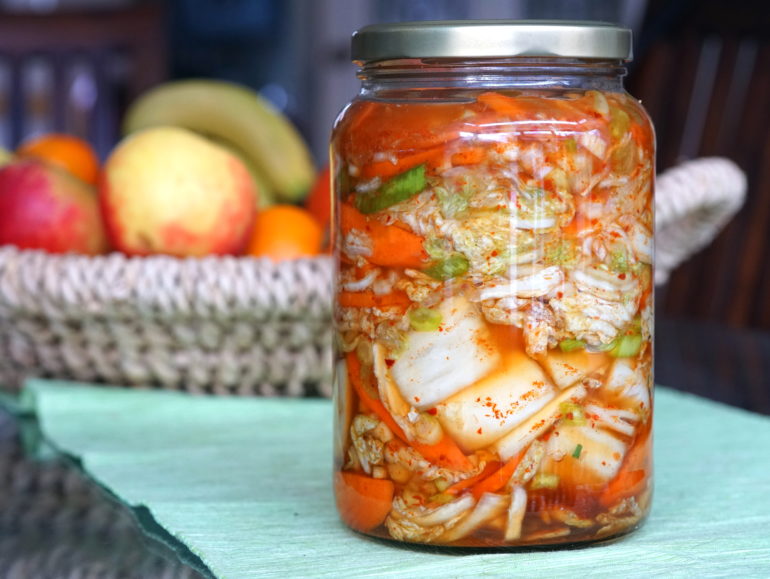Vegan kimchi (the easy way)
| Tags: | Fermentation, Gluten free, Low budget, Nut free |
|---|

Ready-made kimchi can be quite pricey, and it often contains fish sauce. Plenty of reasons to make this Korean flavor bomb at home! Thankfully, it doesn't have to be difficult at all, especially with my simplified (but still super tasty) recipe.
Kimchi is a Korean fermented pickle. There are many different varieties, including ones using radish and cucumber. Most are spicy because of the red chili, but there is also mild 'white' kimchi made from cabbage and Asian pear, without the peppers. The most commonly known kimchi for which I share a recipe here is made from Chinese cabbage with carrots, spring onions, ginger and chili (baechu kimchi).
You may still be a bit hesitant to make your own kimchi, but it really isn't hard at all. Just have to cut up some vegetables, mix them with salt and spices, put them in jars and let them sit for a few days. All in all, it takes about half an hour of active work. Sounds doable, right? The salt and the fact that the vegetables are submerged in their own juice ensures that good lactic acid bacteria can do their job, while bad bacteria and molds are kept away. If you'd like to try more fermentation projects, also try my recipes for sauerkraut and Turkish pickles.
Many kimchi recipes require special ingredients, but I like to stick to things that are available at most local supermarket. If you have a good Asian grocery store nearby, by all means go get some gochugaru (Korean ground chili), but a mix of regular chili flakes and paprika will work just fine. Chili flakes usually have a spicier taste than gochugaru, so that's why I use a smaller amount than what you usually see in kimchi recipes.
Ingredients
- 1 Chinese cabbage (+/- 2 pounds)
- 2 large carrots
- 1 bunch of spring onions (or 1 leek)
- 30 g salt (about 2.5% of the vegetables' weight)
- 2 tablespoons soy sauce (or vegan fish sauce)
- 1-2 tablespoons chili flakes (or Korean gochugaru)
- 1 teaspoon paprika powder
- 1/2 teaspoon smoked paprika (optional, omit if using gochugaru)
- 6 garlic cloves, finely chopped
- 1 tablespoon grated ginger (or ginger powder)
- 1 large 2 liter jar or 2-3 smaller 600-700 ml jars
Cut the Chinese cabbage lengthwise into quarters, remove the hard core and chop the leaves into approximately 3X3 cm pieces. Cut the carrots into thin slices and the spring onions into rings. Place the vegetables in a large bowl and mix with the salt. Let stand for half an hour, so that the vegetables shrink a bit and start to release moisture.
Now add the seasonings (soy sauce to ginger) and toss the kimchi well so that everything is nicely mixed. Fill the jar(s) layer by layer with the kimchi. Press each layer down well with a pestle or sturdy spoon. There should be as little air as possible between them. If the going gets tough, leave the kimchi a little longer, or massage it with your hands to soften the vegetable. Leave at least 2 cm space at the top of the pots.
When all the vegetables are in the pots, press them a little further so that the released liquid is above the vegetables. You can top up the juice with a splash of water if you want. For a safe fermentation it is important that the vegetables are completely submerged. Cover the jars with a loose lid. There must be as little oxygen as possible, but the carbon dioxide that is released during the fermentation must be able to escape.
Put the jars away at room temperature and let them ferment for 3-7 days. Bubbles appear and the taste slowly becomes more sour, just like with sauerkraut. From time to time, push the kimchi down with a spoon, or put a (clean) stone or other weight on top, so that the vegetables remain well submerged in water. A white haze may form on the water at the top of the pot. That is yeast, not dangerous, but also not tasty. Scoop it off and add some extra salt if necessary.
If the kimchi tastes sour enough to you, move the jar to the refrigerator, where the fermentation continues very slowly. Kimchi will stay good for at least 3 months. I recently used kimchi over a year old that had been left in the back of the fridge. Eat the kimchi as a side dish, or use it as a seasoning in stir-fries and soups.
A Dutch translation of this recipe can be found here.

Write a comment